17 December 2019
By Maynard Paton
Results summary for Bioventix (BVXP):
- Satisfactory double-digit growth spearheaded by notable demand for the group’s main antibody.
- Progress beyond 2020 now appears dependent entirely on the new troponin product, revenue from which remains low.
- An unsettling tweak to management’s outlook suggests the pipeline antibodies may require a further five years of development.
- The accounts remain in excellent shape with terrific margins, appealing equity returns and minimal reinvestment requirements that have prompted yet another special dividend.
- The valuation remains rich with an underlying P/E of 28. I continue to hold.
Contents
- Event links and share data
- Why I own BVXP
- Results summary
- Revenue, profit and dividend
- Vitamin D
- Other established antibodies
- Troponin
- Pipeline developments
- Pipeline timescale
- Financials
- Valuation
Event links and share data
Event: Preliminary results and presentation for the twelve months to 30 June 2019 published 21 October 2019
Price: 3,250p
Shares in issue: 5,142,674
Market capitalisation: £167m
Why I own BVXP
- Develops diagnostic antibodies for blood-test machines, direct competition for which is limited due to regulatory hurdles, scientific innovation, customer switching costs and revenue ‘lock in’ through ‘captive’ hospital end-customers.
- Boasts founder/entrepreneurial chief exec who has overseen an attractive growth record, retains an 8%/£14m shareholding and has declared four special dividends.
- Employs asset-light royalty model that encompasses terrific margins, super returns on equity, decent cash flow and no debt.
Further reading: My BVXP Buy report | All my BVXP posts | BVXP website
Results summary
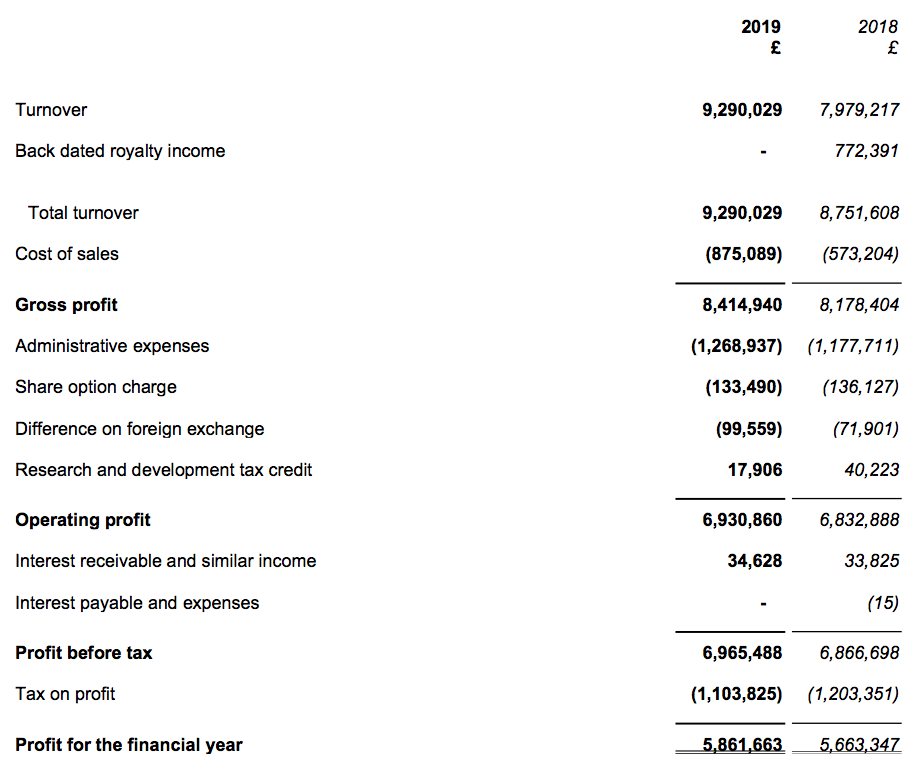
Revenue, profit and dividend
- Bumper first-half figures issued during March had already supported the prospect of a very satisfactory full-year performance.
- Excluding back-dated royalties collected during 2018, revenue advanced 16% and operating profit advanced 14% to deliver record results for the ninth consecutive year:
| Year to 30 June | 2015 | 2016 | 2017 | 2018 | 2019 |
| Revenue (£k) | 4,333 | 5,517 | 7,246 | 8,752 | 9,290 |
| Operating profit (£k) | 3,098 | 4,205 | 5,716 | 6,833 | 6,931 |
| Other items (£k) | - | - | - | - | - |
| Finance income (£k) | 8 | 14 | 56 | 34 | 35 |
| Pre-tax profit (£k) | 3,106 | 4,219 | 5,772 | 6,867 | 6,965 |
| Earnings per share (p) | 50.7 | 69.2 | 96.4 | 110.2 | 114.0 |
| Dividend per share (p) | 32.6 | 42.5 | 51.0 | 61.0 | 73.0 |
| Special dividend per share (p) | - | 20.0 | 40.0 | 55.0 | 47.0 |
- Progress slowed during the second half.
- H2 revenue and profit gained 11% and 8% respectively, versus c24% advances reported for H1:
| H1 2018 | H2 2018 | FY 2018 | H1 2019 | H2 2019 | FY 2019 | ||
| Revenue before back-dated royalties (£k) | 3,523 | 4,457 | 7,979 | 4,365 | 4,925 | 9,290 | |
| Back-dated royalties (£k) | 772 | - | 772 | - | - | - | |
| Revenue (£k) | 4,295 | 4,457 | 8,752 | 4,365 | 4,925 | 9,290 | |
| Operating profit before back-dated royalties (£k) | 2,599 | 3,461 | 6,060 | 3,236 | 3,695 | 6,931 | |
| Back-dated royalties (£k) | 772 | - | 772 | - | - | - | |
| Operating profit (£k) | 3,372 | 3,461 | 6,833 | 3,236 | 3,695 | 6,931 |
- Progress was also influenced by the absence of revenue from a now-terminated product.
- The terminated product once generated annual revenue of approximately £1m, and I estimate it contributed revenue of £125k during the comparable year:
| H1 2018 | H2 2018 | FY 2018 | H1 2019 | H2 2019 | FY 2019 | ||
| Revenue before back-dated royalties (£k) | 3,523 | 4,457 | 7,979 | 4,365 | 4,925 | 9,290 | |
| Loss of product revenue* (£k) | (125) | - | (125) | - | - | - | |
| Revenue before back-dated royalties and loss of product (£k) | 3,398 | 4,457 | 7,854 | 4,365 | 4,925 | 9,290 |
(*estimated)
- Exclude the terminated product, and 2019 revenue perhaps gained 18%.
- Another factor to consider is currency movements.
- Just 5% of 2019 revenue was generated within the UK, with 19% from Europe and perhaps 50% or so from the United States to leave approximately 26% from elsewhere.
- BVXP has never disclosed its revenue growth on a constant currency basis.
- BVXP does not undertake any currency hedging arrangements.
- I understand BVXP’s royalty income (representing 68% of revenue) is translated into GBP when overseas customers pay their royalties during February and August.
- The USD had strengthened 7% against the GBP during the twelve months to February 2019 and the twelve months to August 2019.
- Currency movements may therefore have contributed up to 7% of the aforementioned 18% revenue advance (adjusted for back-dated revenue and the terminated product).
- At least the dividend increase was a straightforward 20%, with the final payout raised 19%.
- The results highlight was the commendable declaration of a 47p per share special dividend — the fourth extra payout during the last four years.
- In fact, BVXP has effectively distributed its entire earnings as ordinary or special dividends between 2016 and 2019.
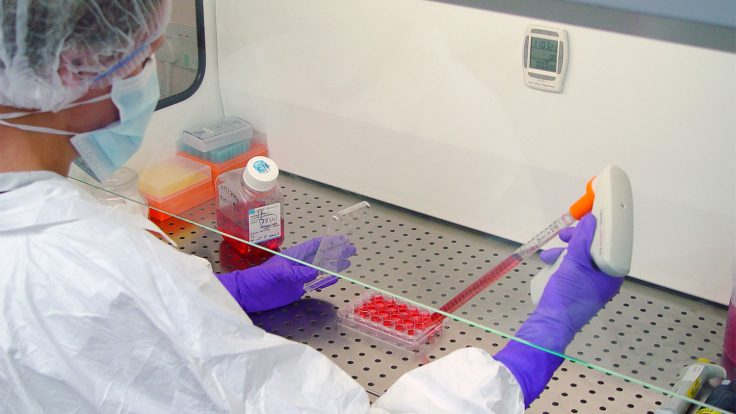
Vitamin D
- BVXP’s vitamin D antibody remains the group’s best-seller — the product represented 46% of 2019 revenue:
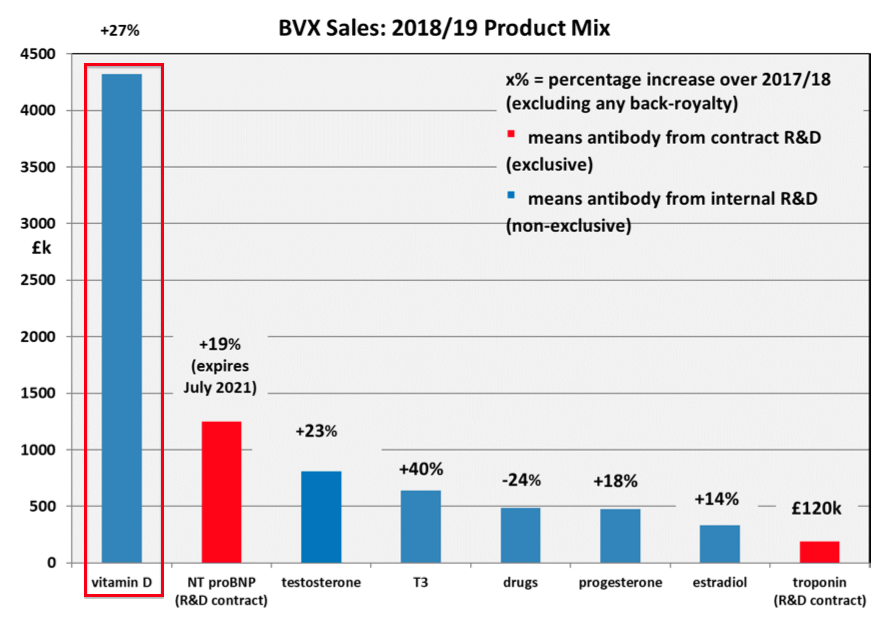
- Vitamin D full-year revenue improved by 27%, which BVXP said had “surpassed our expectations”
- BVXP expressed some caution about vitamin D growth (my bold):
“Despite this pleasing news, we are increasingly sure that price pressure… is balancing the increase in market volume leading to a flattening total market in US Dollar terms. This is clearly evidenced by a number of our vitamin D customer revenue streams which, after a period of significant growth now appear to have reached a plateau.”
- The “plateau” reference about vitamin D was used within the previous two annual statements:
“…we nevertheless perceive a plateauing of the vitamin D testing market.” (2018)
“Our prudent belief is that the vitamin D market will plateau in the near future”. (2017)
- Within the 2016 annual statement, BVXP said (my bold): “we remain optimistic that revenues from vitD3.5H10 will continue to grow modestly over the next year.”
- Despite the references to “plateau” and “modestly“, vitamin D revenue has soared an estimated 93% during the last three years.
- Perhaps BVXP likes to under-promise and over-deliver.
- Or perhaps BVXP has been surprised by “certain individual customers”. This results RNS stated:
“An element of the growth in sales this year has come from certain individual customers who appear to be performing well in the downstream market with our antibody.
Diazyme (San Diego, US) have made progress with their vitamin D assay which has the attractive feature of being run on general “chemistry” analysers.
Boditech (South Korea) is another Bioventix customer who use the vitD3.5H10 antibody and has achieved significant success in the growing Asian vitamin D market with their vitamin D assay.”
- Or perhaps vitamin D revenue will actually plateau during 2020.
- I understand BVXP’s royalties on vitamin D remain at 4% to 5% regardless of the customer. Other BVXP antibodies earn 2% royalties.
- I also understand that vitamin D ‘plateauing’ could mean the associated growth reduces to wider industry levels of between 5% and 10% per annum, rather than stagnate completely.
Enjoy my blog posts through an occasional email newsletter. Click here for details.
Other established antibodies
- Five of BVXP’s other six “established core” antibodies increased their revenue during 2019:
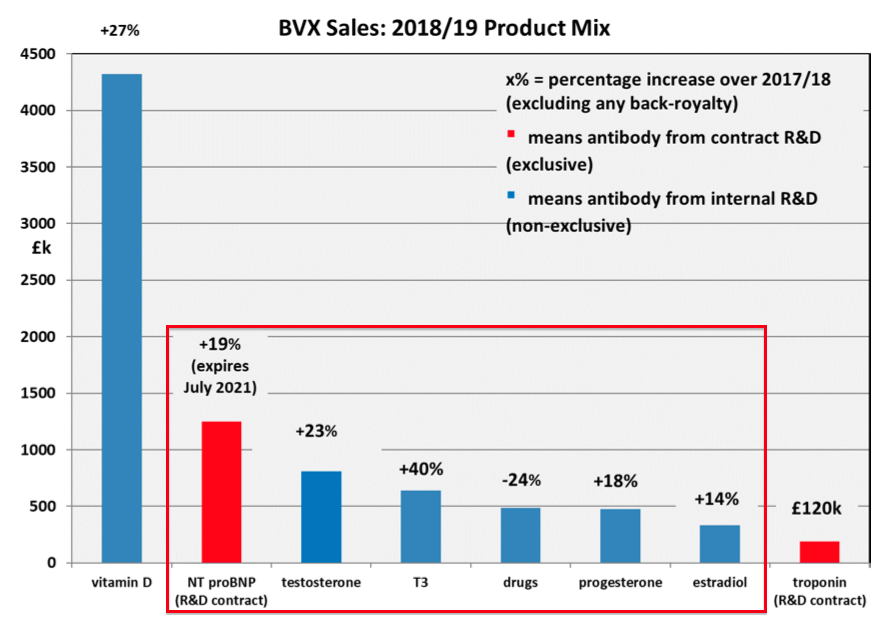
- Total revenue from the six gained 14% to almost £4m.
- BVXP once again claimed “the increase in most of these core antibodies that are sold to a number of customers in many countries does not have a single explanation over and above the 5-10% increase in the global diagnostics industry that is reported by third party analysts.”
- Revenue from the NT proBNP antibody will expire during 2021.
- NT proBNP’s £1.25m revenue represented 13% of total group revenue:
| Year to 30 June | 2016 | 2017 | 2018 | 2019 |
| Revenue | ||||
| Vitamin D (£k) | 2,200 | 2,750 | 3,400 | 4,300 |
| Troponin (£k) | - | - | - | 120 |
| Established antibodies (£k) | 1,600 | 2,100 | 2,450 | 2,730 |
| Contract NT proBNP (£k) | ?? | 610 | 1,050 | 1,250 |
| Terminated product (£k) | 800 | 1,000 | 125 | - |
| Other products (£k) | 917 | 786 | 1,727 | 890 |
| Total (£k) | 5,517 | 7,246 | 8,752 | 9,290 |
- All other sources of revenue will have to expand by a collective 16% to make up the forthcoming £1.25m shortfall.
Troponin
- BVXP’s new troponin antibody — used to help detect potential heart attacks — produced 2019 revenue of just £120k. I understand £50k was earned during H1 and £70k was earned during H2.
- The 2018 statement admitted that troponin sales had been “below our expectation”.
- The 2017 statement claimed the slow troponin take-off was due to hospital staff undertaking an “education period”:
“Whilst it is clear that a quicker test will be of benefit to patients, clinicians and hospital budget holders, it is also clear that there is likely to be an education period during which clinicians become comfortable with a significant change in diagnostic practices”.
- Back in 2016, BVXP had talked of “significant” troponin sales by 2018 (my bold):
“Troponin remains an important product for Bioventix’s future performance as we expect to commence significant sales during the financial year 2017/2018 and we anticipate that this revenue will offset revenues of £0.7 million – £0.8 million from another product which will terminate during this period.”
- For what it is worth, BVXP’s house broker reckons troponin revenue can increase to £0.5m for 2020, then to £1.1m for 2021 and then to at least £3m by 2025 (click here to read the full broker note).
- According to investment blogger Roger Lawson, BVXP management described the near-term troponin forecasts as “reasonable” at the recent AGM.
- BVXP will only say in an RNS that troponin is expected to have a “significant influence” on revenue.
- The results presentation indicated growth beyond 2020 could be dependent entirely on troponin (see Pipeline timescale below).
Pipeline developments
- BVXP’s product-pipeline chart contained two changes:
- Biotin was demoted from having a “high” potential value to a “medium” potential value, and;
- Pollution biomonitoring was introduced and marked as having a “high” potential value and a “medium” probability of success:
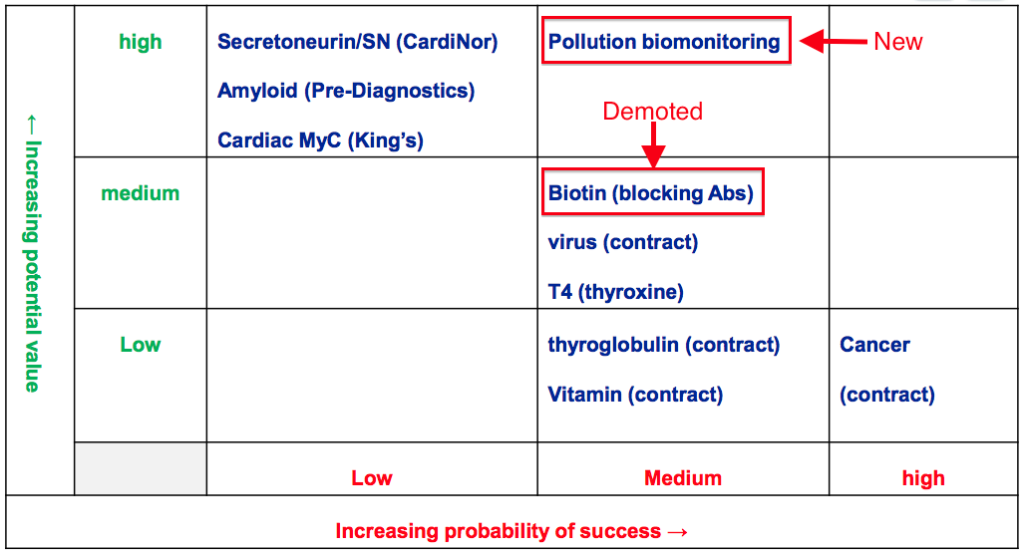
- The biotin change seemed to be caused by a large potential client (which I understand to be Roche) creating its own antibody (my bold):
“We believe that the largest potential customer for these antibodies has solved their particular biotin problem through internal means and no longer represent a sales opportunity for Bioventix. However, we know that other customers exist reassuring us that a modest potential market exists for these biotin interference products should we find a technical solution.”
- BVXP said that the other potential customers would receive early biotin antibodies by the end of this month.
- Pollution biomonitoring sounds intriguing — the project tests for the effects of air pollution on people:
“Currently, atmospheric pollution is monitored using static air analysers but direct human exposure or “biomonitoring” is not routinely performed as no convenient tests exist. We are currently making antibodies and prototype tests that could be used in such direct human exposure biomonitoring. This project is outside our normal clinical focus but we speculate that human pollution biomonitoring could become significant in the years to come as populations become increasingly aware of the impact of pollution on health.”
- Given the position on the development chart, pollution biomonitoring appears to be BVXP’s best risk/reward opportunity within the pipeline.
- Among the other pipeline activities:
- A development partner ought to confirm next year whether secretoneurin could be a useful cardiac biomarker, and;
- £300k has been invested in another development partner that will (one day) assess the amyloid antibody for dementia testing.
- The secretoneurin and amyloid partnerships have already been going for more than three years.
- Whether any of BVXP’s pipeline developments ever bear fruit remains to be seen.
- BVXP says an antibody can take between four and ten years to go from the laboratory to earning an income (that is, assuming the antibody actually becomes commercially viable).
- For perspective, development of BVXP’s troponin antibody started during 2006 and is only now earning a (small) return:

- Bear in mind, too, that BVXP has confessed that “there are no antibodies in the future pipeline that are comparable to troponin in clear potential value and the ability to influence revenues in the next few years.”
Pipeline timescale
- This results RNS contained an unsettling change.
- The outlook commentary referred to “2025/2030”:
“Beyond that, growth will be linked not only to the troponin project but also our continued research activities as we look to seed additional projects that will germinate in the period 2025/2030 to create additional shareholder value.”
The outlook commentary within the 2018 results used the exact same text but instead referred to “2020/2030”:
“Beyond that, growth will be linked not only to the troponin project but also our continued research activities as we look to seed additional projects that will germinate in the period 2020/2030 to create additional shareholder value.”
- The outlook commentary within the 2017 results also referred to “2020/2030”:
“Beyond that, growth in the period 2018/2020 will be linked to our troponin project and the success of Siemens in their product launches around the world. We continue our research activities as we look to seed additional projects that will germinate in the period 2020/2030 creating additional shareholder value.”
- The outlook commentary within the 2016 results also referred to “2020/2030”:
“Beyond that, growth in the period 2017 2020 will be linked to our troponin project and the success of Siemens in their product launches around the world. We continue our research activities as we look to seed additional projects that will germinate in the period 2020/2030 creating additional shareholder value.”
- The outlook commentary within the 2015 results also referred to “2020 to 2030”:
“The challenge for our continued research activities will be to seed additional projects that will germinate in the period from 2020 to 2030 to allow us to create further shareholder value.”
- BVXP’s additional pipeline projects had been expected to “germinate” between 2020 and 2030.
- Now BVXP says the expected germination period is 2025 to 2030.
- The timeframe change implies the current pipeline of products may require a further five years of development before potentially becoming commercial.
- BVXP’s presentations partly explain what may have occurred.
- The slides from March’s first half presentation included these bullet points:

- The slides for these annual figures included these bullet points:
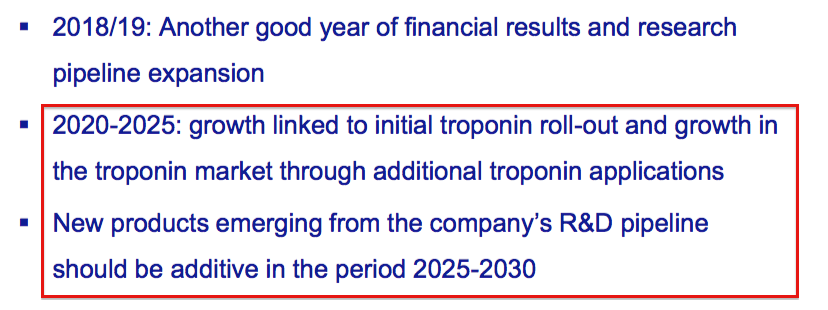
- The germination period of 2020-2030 has been split into two, with 2020-2025 progress dependent on troponin and 2025-2030 progress also dependent on the pipeline developments.
- The RNS text before 2019 suggested the development projects could have become commercial between 2020 and 2025 — which is how I interpreted the text.
- Mind you, perhaps BVXP has simply clarified the germination period — and the development projects were never likely to become commercial before 2025 anyway.
- Nonetheless, seemingly minor changes in outlook commentaries can be instructive.
- Example 1) Andrews Sykes (ASY), which included the phrase “cautiously optimistic for further success” within the group’s outlook statement for six years until 2018.
- ASY’s 2018 results then omitted the phrase, implying management was not “cautiously optimistic for further success” — at least for 2019.
- Sure enough, first-half profit for 2019 dropped 25%.
- Example 2) Tasty (TAST), which used the phrase “since the year end trading has been in line with expectations” within the group’s outlook statement for four years until 2016.
- TAST’s 2016 results then included the word “broadly [in line]” — suggesting trading was not quite up to expectations.
- Sure enough, the firm’s expansion plans started to slow, and falter badly thereafter.
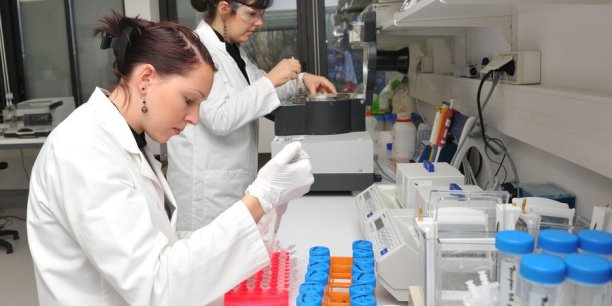
Financials
- BVXP’s accounts remain in extremely good shape:
| Year to 30 June | 2015 | 2016 | 2017 | 2018 | 2019 |
| Operating margin* (%) | 71.5 | 76.2 | 78.5 | 76.0 | 74.6 |
| Return on average equity (%) | 43.3 | 47.2 | 53.6 | 47.5 | 53.7 |
(*before back-dated royalties)
- The 75% operating margin underlines the lucrative nature of BVXP’s royalty income, although the margin was the lowest since 2015.
- BVXP hinted the margin might improve during 2020:
“The cost of sales has been influenced (i.e. increased) to some extent by a reduction in antibody stocks. This is a transient effect that should be reversed during 2019/20 of approximately £200k on external contract chemistry services linked to the biotin and pollution projects described below.”
- BVXP’s return on equity figures remain attractive.
- The incremental returns are impressive. During the last five years, earnings have advanced by £4.0m while shareholder equity (i.e. net assets) has increased by £5.6m. The resultant incremental return on equity is therefore £4.0m / £5.6m = a stunning 71%.
- The 71% calculation is a result of BVXP lifting its earnings while maintaining a similar level of shareholder equity since 2017:
| Year to 30 June | 2014 | 2015 | 2016 | 2017 | 2018 | 2019 |
| Earnings (£k) | 1,815 | 2,557 | 3,494 | 4,922 | 5,663 | 5,859 |
| Shareholder equity (£k) | 5,236 | 6,584 | 8,207 | 10,144 | 11,011 | 10,826 |
- BVXP has kept its shareholder equity at the £11m mark following the payment of ‘surplus’ earnings as special dividends.
- BVXP does appear to be one of those very special businesses that can lift earnings without requiring too much extra capital.
- Cash in the bank fell by £0.4m during the year. Earnings of £5.9m were offset by total dividend payments of £6.2m plus a £0.1m partner investment.
- Cash working-capital movements were minor during 2019:
| Year to 30 June | 2015 | 2016 | 2017 | 2018 | 2019 |
| Operating profit* (£k) | 3,098 | 4,205 | 5,691 | 6,060 | 6,931 |
| Depreciation (£k) | 46 | 42 | 39 | 58 | 76 |
| Cash capital expenditure (£k) | (114) | (21) | (22) | (108) | (85) |
| Working-capital movement (£k) | (279) | (581) | (570) | (539) | (47) |
| Net cash (£k) | 4,131 | 5,380 | 6,167 | 6,987 | 6,537 |
(*before back-dated royalties)
- During the last five years, just £2m has been needed for additional working capital from an aggregate operating profit of £27m.
- Capital expenditure was very modest, too, although £300k will be spent during 2020.
- Year-end cash of £6.5m surpassed the “approximately £5m” that BVXP says is “sufficient to facilitate operational and strategic agility with respect to possible corporate or technological opportunities that could arise in the foreseeable future.”
- The ‘excess’ cash has gone towards funding a 47p per share/£2.4m special dividend.
- The balance sheet carries no bank debt and no pension complications.
Valuation
- BVXP’s outlook remarks included (my bold):
“Looking ahead to the future, we keenly anticipate the roll-out of high sensitivity troponin assays and modest growth from additional vitamin D and other antibody sales and royalties.”
- The company does like to use the word “modest”.
- Last year BVXP said:
“We are delighted to be able to report such positive news for the current year. Looking ahead to the future, we keenly anticipate the roll out of the Siemens troponin project and modest growth from additional vitamin D antibody sales and royalties.”
- Here is the outlook from the year before (my bold):
“For the financial year 2017/18, our challenge will be to make up for the approximately £1 million of lost sales mentioned above with revenues from the newly launched Siemens troponin project and modest growth from additional vitamin D antibody sales and royalties.”
- And the year before that (my bold):
“Furthermore, we remain optimistic that further modest growth next year will come from additional vitamin D antibody sales and royalties.”
- And the year before that (my bold):
“Furthermore, we remain optimistic that further modest growth in the next two years will come from additional vitamin D antibody sales and royalties.”
- Each time the “modest” growth projection turned into a welcome, double-digit profit advance.
- At some point, BVXP will actually deliver modest growth of perhaps a single-digit advance. Remember, H2 profit gained only 8% this year.
- BVXP’s 2019 operating profit of £6.9m taxed at the 16% rate applied within these results gives earning of £5.8m or 114p per share.
- Subtracting the £6.5m/127p per share cash position from the 3,250p share price gives an enterprise value of 3,123p per share.
- Dividing that 3,123p by the 114p per share earnings estimate gives an underlying trailing P/E of almost 28.
- Assume the cash position is not surplus to requirements — remember, BVXP wants to keep £5m “to facilitate operational and strategic agility with respect to possible corporate or technological opportunities that could arise in the foreseeable future” — and the trailing P/E is almost 29.
- Either way, the rating is undeniably rich at close to twice the market average.
- However, BVXP’s growth history, operating margin and return on equity are perhaps (at least) twice as attractive as the market average.
- BVXP’s presentation (unusually) includes broker forecasts, which predict revenue growing by 9% and pre-tax profit improving 10% for 2020 (in green):
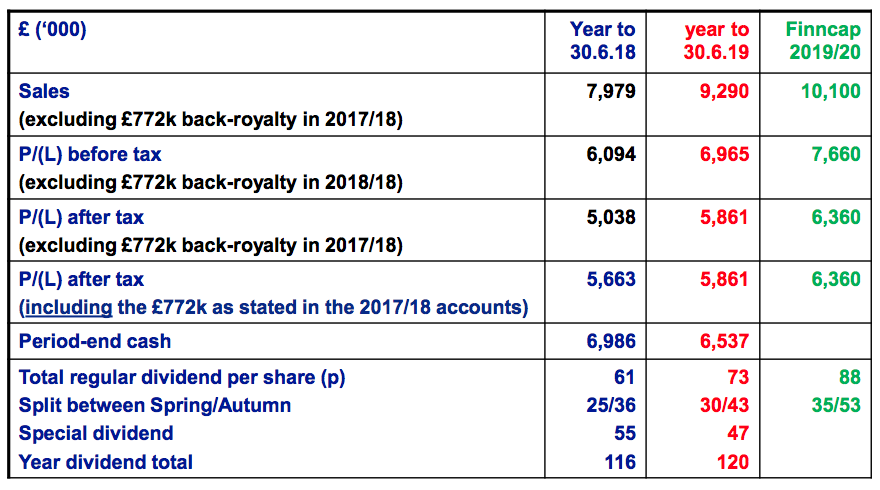
- Last year the broker expected revenue of £9.0m and an adjusted pre-tax profit of £7.1m for 2019 (in green):
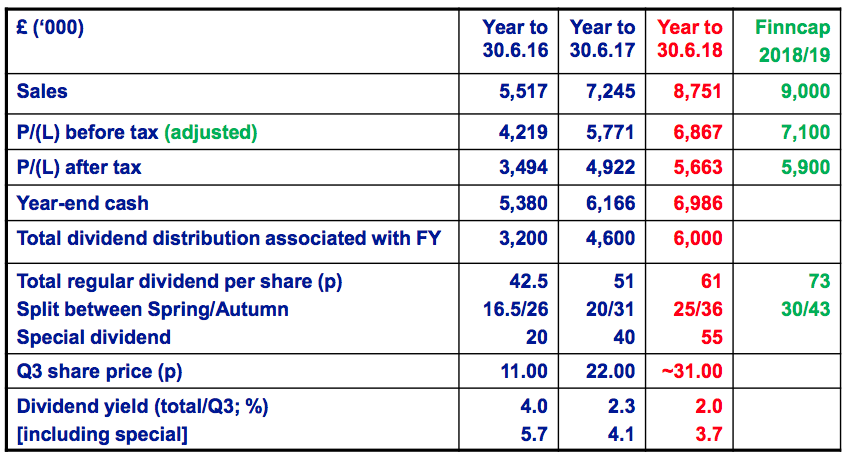
- The revenue prediction was £0.3m below the actual £9.3m acheived.
- The pre-tax profit prediction was £135k above the actual £7.0m acheived.
- The trailing 73p per share ordinary dividend supports a 2.2% yield.
- Given BVXP has effectively distributed all of its earnings as ordinary and special dividends since 2016, the 3.5% yield based on the 114p per share earning guess may be a more appropriate income to assess the valuation.
Maynard Paton
PS: You can receive my blog posts through an occasional email newsletter. Click here for details.
Disclosure: Maynard owns shares in Bioventix.

Thanks for your analysis Maynard. Always good to read. HNY to you and your family.
Thanks Nick. All the best for 2020.
Maynard
Bioventix (BVXP)
Publication of 2019 annual report
Just catching up with this annual report, published last October.
A simple text-only report. Just the type I like.
As before, BVXP’s accounts are unusual as they are presented in the ye olde UK GAAP format, which does not provide as much disclosure as the usual IFRS standard.
AIM Rule 19 allows UK companies without subsidiaries (such as BVXP) to present their accounts using UK GAAP. UK businesses that are formed of a parent company plus one or more subsidiary operations have to present group accounts using IFRS.
Here are the points of interest:
1) Corporate governance
Last year BVXP cited a website document as its corporate governance statement.
This year the statement has been included in the annual report:
Part 4 is interesting:
“Management accounts contain a number of indicators that are designed to reduce the possibility of misstatement in the financial statements”.
The 2018 accounts included back-dated royalties and so did the 2014 numbers.
More concerning is the misstatement in the subsequent first-half results for 2020 (review coming soon!), whereby revenue and profit were overstated in the original RNS by £0.2m.
I can’t help thinking there is a connection between the various accounting corrections and the outsourcing of the finance director function (see Director remuneration below).
My suspicion is heightened because the outsourced FD — a non-exec — heads the audit committee:
I think one of the other two non-execs ought to head the audit committee to ensure the figures are correct.
Part 8 is interesting. For the first time “succession planning” is mentioned by BVXP:
Chief executive Peter Harrison has been a class act for shareholders and a change of leadership will therefore create some doubt. Mr Harrison is 61. BVXP employs only 16 people (see Employees below) and I’m not even sure there has been a need for a ‘second-in-command’ Operations Manager up to now.
2) Director remuneration
BVXP has published its first proper director-remuneration report:
Mr Harrison’s basic pay climbed 6% while the non-execs both received a 3% rise. The chief exec’s pay and bonus seem very reasonable considering the group’s longer-term performance. The bonus was £45k lower than last year and is still calculated using “EPS and share price parameters, together with a smaller R&D element”. Would be useful to know what the EPS and share-price parameters are.
BVXP pays £19k to the outsourced FD’s partnership:
£19k is equivalent to c8 weeks’ work for an FD on £120k a year, and suggests the FD works for BVXP on average less than one day a week.
Director options remain under control:
c32k options compare to c86k in total. Corporate governance best practice advises non-execs should not be granted options, but the performance of BVXP over time — and the ‘thin cat’ board pay — suggest these non-exec options can be overlooked.
3) Audit
Nothing too untoward in the audit report.
Scope is 100%:
Confirmation that customers who pay royalties “self-declare” payments to BVXP:
The valuation of BVXP’s investments (two Norwegian research firms) is a new audit concern:
Materiality remains at the standard 5% of pre-tax profit:
4) Employees
BVXP’s employee-related ratios remain strong:
The workforce gained one employee to 16 (BVXP’s powerpoint says there were 12 full-time equivalents), and each bears a total cost of £65k to the group — last year the figure was £67k.
Each employee on average generated a superb £580k of revenue for 2019, down a fraction from £583k last year but well above the £165k for 2009.
Total employee costs represented 11.3% of revenue, down from 11.6% last year and still below the 12%-plus from 2016 and before.
I am hopeful BVXP’s stratospheric 70%-plus operating margin may even increase further should the company continue to grow its revenue and keep its employee team so small.
Total employee options represent less than 2% of the share count:
5) Taxation
Earnings are bolstered a little by an R&D tax credit:
The tax credit increased by a notable 87% to £239k for 2019, while R&D costs increased by 28% to £1,116k. I am not sure of the relationship between R&D spend and the R&D tax credit, but the credit can fluctuate and may at times flatter earnings a tad.
6) Investment
This entry reflects the Norwegian investments:
Note that 1 GBP bought 10.83 NOK at the balance sheet date, but currently buys 12.92. BVXP’s investments have therefore declined by 16% in GBP. The investments are stated at cost.
7) Stocks
Not often a business can lift revenue by 16% and also see its stock level fall by 16%:
Stock turn is the £875k / £239k = 3.7x — which is about 100 days and for most businesses is not great. But for BVXP, stock represents only 2.5% of revenue — and the business is dependent mostly on its royalty/licensing income rather than sales of physical stock.
8) Debtors
Trade debtors is often the largest figure within the debtors (or receivables) note. But for BVXP, prepayments and accrued income is the largest.
BVXP carries a lot of accrued income — which reflects revenue earned during the period but where the customer had not yet been invoiced at the balance-sheet date.
(Trade debtors reflect revenue earned during the period where the customer has been invoiced).
This accrued income relates to the company’s collection of royalties. From this extract of the 2016 results narrative:
“Approximately three quarters of Bioventix sales are generated from customer royalties. These are based on our customers’ global sales which are then factored by a royalty percentage and then sent to Bioventix around 2 months after the end of each half year.”
BVXP’s customers inform (or “self declare“) BVXP of their global sales after the period end, and BVXP then invoices the customers for the appropriate royalty sum.
As such, the revenue to be collected is deemed to be accrued income — i.e. the revenue had not been invoiced at the balance-sheet date.
Anyway, the year-end prepayment and accrued income figure for 2019 is equivalent to 51% of royalty revenue, which compares to between 54% and 56% for 2014-2018. I am pleased the backlog of customer payments is not growing faster than royalty revenue.
I see trade debtors has dropped from £824k, or 25%, to £697k, which partly reverses the 82% increase during 2018. Average trade receivables are 8% of revenue, in line with the 6-9% seen since 2013.
9) Administration expenses
I like this old-school expenses schedule:
Greater legal fees and repair costs, and lower travel expenses and bad debts.
Maynard